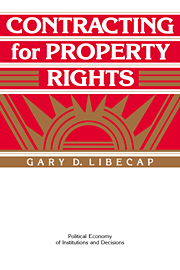Book contents
3 - Contracting for mineral rights
Published online by Cambridge University Press: 24 March 2010
Summary
INTRODUCTION
Of the four cases examined in this volume, efforts to assign locally recognized private mineral rights and subsequently to adjust state and federal land law to recognize those contracts were the most routine and uncontroversial. Agreements within the mining camps to outline procedures for claiming and enforcing private mineral rights were completed rapidly, and there appears to have been broad-based political support for incorporation and refinement of the mining camp rules into state and federal law. The history of these efforts is examined in this chapter. The reason for contracting was potential common pool losses, which emerged with the discovery of fabulously rich gold and silver deposits on previously unclaimed and unsettled federal land in the Far West between 1848 and 1890. Private claims to parcels of land were made as miners rushed to the region following the ore discoveries, but there was no existing legal framework for formally recognizing or protecting those mineral “rights.”
Competitive pressures for what were effectively, open access mineral lands were intense. For example, within months of the first ore discoveries on Sutter Creek in 1848, the population of California rose from a few thousand to 107,000 and by 1860, to 380,000, with most people concentrated in the mining camps of the central Sierra Nevada foothills. In the absence of legal rules to assign ownership of the valuable mineral lands, there was the potential for violent contention for control.
- Type
- Chapter
- Information
- Contracting for Property Rights , pp. 29 - 50Publisher: Cambridge University PressPrint publication year: 1990
- 1
- Cited by



